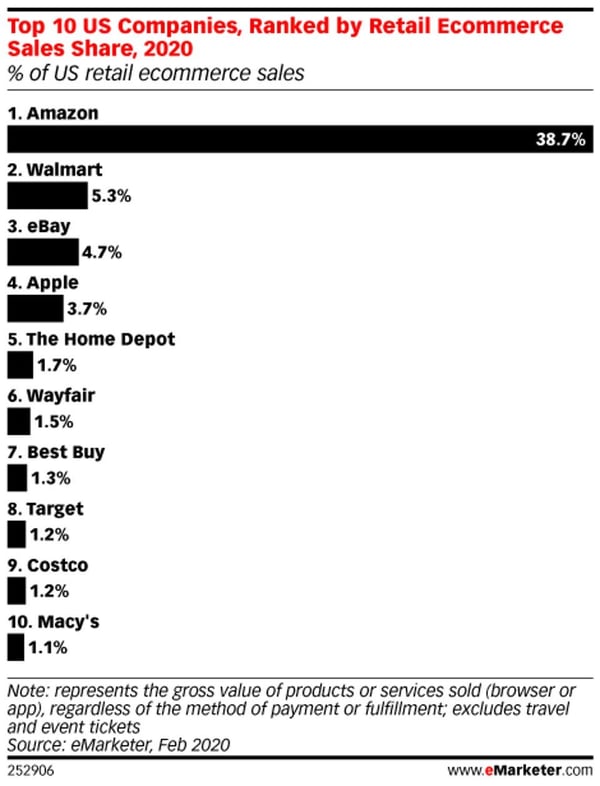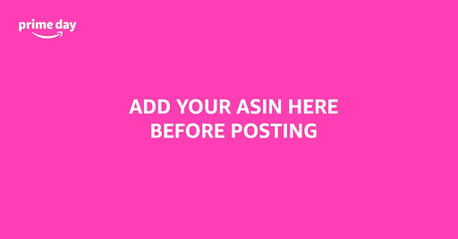Online shopping is growing rapidly, and brands need to consider how Amazon fits into their overall business model.
A few years ago Amazon was barely a consideration for many brands. But now it’s an obvious revenue and growth opportunity for businesses across a wide variety of categories.
In this article, we’ve broken down how to assess the Amazon opportunity, and the right approach to setting marketplace goals. Jesse Chembars, Bobsled Project Manager, also provides insight about tried and tested strategies brands can implement to drive growth on the channel.

Is Amazon The Right Channel For My Brand?
Before we dig into Amazon-related specifics, let’s consider the Big Picture. Not all channels are created equal - each has unique pros and cons.
The natural starting point is brand identity. How does your brand fit into the market at large? This line of questioning should initiate a long and hopefully fruitful discussion about target customer demographics, unique selling propositions and the specifics of your brand’s “personality”. Once you've established these crucial grounding principles, the next step is to consider all the different ways you could potentially reach customers.
There is of course the traditional brick-and-mortar path to consider. The U.S. Department of Commerce reported that non-online channels still accounted for 84% of total retail sales in 2019.
At the same time, online’s staggering growth is undeniable. The same report concluded that from 2018 to 2019, total online sales grew by a whopping 14.9%. eMarketer recently published a demographic breaking down online market share for the top US companies.

Above: Top 10 US Companies, Ranked by Retail Ecommerce Sales Share. Image from eMarketer
At the present time Amazon is the largest online marketplace by a big margin. But of course, this doesn’t mean Amazon is a good channel for every brand. Ensuring that your brand’s existing or potential Amazon presence aligns with your overall model is crucial.
Brands also need to evaluate changing consumer patterns. Even if your brand has avoided selling on Amazon directly, if a demand exists, there’s a good chance other parties may be selling your products on the Amazon marketplace. If this is happening to your brand, it means that you aren’t in control of how your brand is being represented on the world’s largest marketplace.
The rise of Amazon has changed how consumers shop across most categories, and getting clear on exactly how Amazon fits into your broader brand awareness strategy is a necessity.
What Type Of Sales Can I Expect On Amazon?
If Amazon is indeed a good channel for your brand, it’s important to establish some defined marketplace goals.
Whether you’re already selling on the platform, or you’re considering taking the plunge and launching a new account, it’s important to analyze the competition and figure out the lay of the land. Here’s how to approach this task.
a) Identify the competition
Doing a deep dive on the most relevant sub categories will be highly enlightening for most brands. A simple Share-of-Voice analysis will illustrate which brands are dominating, product display page trends and average price-points.
b) Use tracking tools to estimate competitor sales
Once you’ve ascertained which competitor products are on top, you can use tracking software to estimate total monthly unit sales and revenue for these products. At Bobsled, we use Jungle Scout to do this type of competitor analysis, but there are a host of similar software options available. Such estimates will give you an indication of the total size of the pie in your niche. These figures will also help you decide whether to sell your entire catalog on the Amazon channel, or merely a limited selection.
c) Figure out the best way to differentiate
The Amazon algorithm rewards well-tenured product listings with lots of positive reviews, so finding a way to effectively differentiate your brand is important. There are several ways to stand out from the pack. Higher or lower price-point, aggressive PPC spend and A+ content are just a few options at your disposal.
d) Set goals, track performance
It takes time, money and effort to effectively manage each active Amazon product listing. Create Amazon goals for your brand against relevant competitor data points (total monthly revenue, total units sold), and implement advertising to drive growth.
e) Consider other brand awareness metrics
In addition to competing for Amazon rank and revenue, brands should also be thinking about other metrics, such as Customer Lifetime Value and customer acquisition costs. Brand registered sellers and vendors can utilize New-To-Brand metrics which identifies costs with acquiring both new and existing customers via Amazon advertising. You can then take these metrics and compare them with other channels e.g. your own ecommerce store, in order to make decisions about how to allocate advertising spend across competing channels.
Discover Your Real Amazon Competition!
3 Ways To Promote Your Brand (To Grow Amazon Sales)
If your brand is active on Amazon, it’s in your best interest to leave no stone unturned when it comes to promotional efforts.
 “Amazon amasses a huge amount of traffic primarily from a loyal base of online shoppers,” explains Bobsled Project Manager Jesse Chembars.
“Amazon amasses a huge amount of traffic primarily from a loyal base of online shoppers,” explains Bobsled Project Manager Jesse Chembars.
“In addition to a sales channel, Amazon can be viewed as a powerful marketing tool.”
- Jesse Chembars, Bobsled Project Manager
Here are Jesse’s three core promotional recommendations.
1. Product Inserts
Product inserts can markedly improve the unboxing experience.
“Sometimes online marketplace transactions feel a little impersonal, but a well-crafted product insert can elevate the experience,” Jesse says. “The excitement of receiving your Amazon order might dissipate pretty quickly if you’re confused in any way about the product you’ve just purchased. An insert with some basic product information and instructions can remedy most immediate issues.”
According to Jesse, product inserts serve a dual purpose when it comes to product reviews.
“A high-quality product insert that contains useful customer service information should help limit negative product reviews. On top of that, you’re really enhancing your chances of receiving positive feedback from Amazon shoppers. Although you can’t explicitly ask for a review within an insert, they illustrate a high level of customer service, and this won’t go unnoticed for a lot of Amazon shoppers.”
Finally, there’s customer connection benefit to consider.
“Amazon has very strict rules about brands connecting directly with Amazon customers on the marketplace, but brands do currently have the ability to offer a product warranty on an insert,” Jesse says. “Simply include a url or QR code on the insert so the customer can reach a landing page and enter their email address to sign up for the warranty. This will help you build a more direct connection with shoppers who buy your products on the Amazon marketplace.”
Services such as Beaconstac provide QR codes for product inserts. For more best practices regarding product inserts, read Bobsled CEO Kiri Masters’ post on Forbes.com 5 Types Of Product Packaging Inserts That Brands Are Using To Connect With Their Customers.

Above: Product insert from scooter brand Micro
2. Email

Email marketing offers brands a fantastic way to nurture existing customers.
“It’s no secret that new-to-Amazon brands with sizable email lists can often generate traction far quicker compared to those that don’t,” Jesse says. “But there needs to be an intelligent email marketing strategy in place. Simply blasting a list several times a day with a one-size-fits-all offer is not the right approach."
The key according to Jesse is personalization.
“I urge all of my clients to think about the different types of customers who shop online,” he says. “Some customers are Prime members and therefore extremely loyal to Amazon. Others are far more channel agnostic.”
“Often times brands will push offers on their entire email list that lead to their ecommerce website. They understandably want a better profit margin and closer control of the customer experience. But most Amazon-loyal customers aren’t going to be interested, simply because they only want to make online purchases on Amazon. Understanding all the different segments within a list and creating personalized emails will yield much better results.”
Above: Example of an Amazon-focused Valentine’s Day marketing email
3. Social Media
To grow their Amazon presence, brands can manipulate the ‘viral’ nature of social media to their advantage.
“For better or worse, social media is the modern day version of the watercooler,” Jesse explains. “A brand can expand their reach dramatically with some standard calls to action such as ‘tag a friend’ or ‘hit like and share’. If it’s a compelling offer, word gets around, brands can generate a huge volume of sales on Amazon very quickly, and they can hopefully acquire more social followers too.”
Once again, understanding the behavior patterns of different customer segments is key when it comes to effective social media marketing strategies.
“On Prime Day, the vast majority of social media users want Prime Day offers, not an offer that leads to your own website,” Jesse says. “Amazon has even started offering Prime Day creative assets that brands can customize for their email and social media marketing efforts.”


Above: Examples of Amazon’s 2019 Prime Day social media creative assets for brands
Tactics To Avoid
In the past, there were a bunch of additional different levers that brands could pull in order to grow their Amazon presence. Over time, Amazon has ruled more and more strategies against their Terms of Service (TOS).
The following are all now in violation of TOS and should be avoided at all costs.
- Asking friends and family to write Amazon product reviews
- Asking existing non-Amazon customers to write Amazon product reviews
- Acquiring product reviews from reviewer groups
- Post-purchase email sequences
- Asking for reviews on product inserts
- Including links to social media accounts on product inserts
Amazon’s current seller policies can be found here. If you need further clarification regarding promotional strategy compliance we highly recommend you contact the Amazon support team.
The Worst Plan Is No Plan
For a lot of brands, the Amazon marketplace is still shrouded in mystery. If you’re unsure of how Amazon fits into your overall business model, and don’t have a clear idea of how to drive growth on the channel, there’s a good chance you’re leaving money on the table.
If you’d like to connect with a Bobsled team member to discuss your Amazon strategy please click the consultation button and complete the form.
Tagged: PPC Advertising, Seller & Vendor Central, Amazon Account Management
.png)



